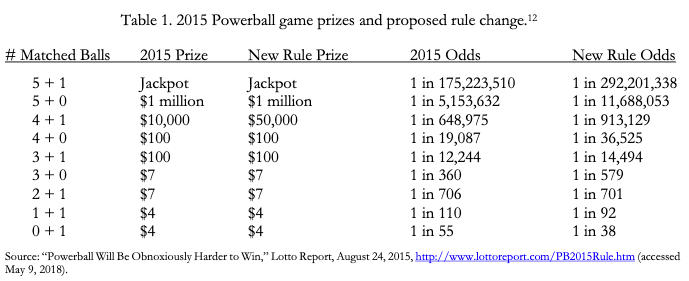9483
AiS
Session 3b


Joshua
Foster

Agenda
- Case: Powerball -- Somebody's Gotta Win.
- Prospect Theory, Part II: Probability Weighting Function
How does the Powerball lottery work?
Why were the rules changed?

Why do people buy lottery tickets?
How should a person calculate the value of a lottery ticket?
Linearity in Probabilities (LiP).
Utility is weighted by the probability of the outcome. Therefore, if the probability of the outcome doubles then the weight it places on expected utility also doubles.

Survey questions: Choose between the following.
| Gamble A: 100% chance of gaining $3000. Gamble B: 80% chance of gaining $4000 and a 20% chance of gaining $0. | Gamble A: 25% chance of gaining $3000 and a 75% chance of $0. Gamble B: 20% chance of gaining $4000 and a 80% chance of $0. |
 |  |
Note, in both cases:
- 4000 is 0.8 times as likely 3000.
- Difference in preferences contradicts LiP.
Start with the first version of the question.
Preferring 3000 for sure over 4000 with 80% probability:
| $u(w+3000)$ | $>$ | $0.8\cdot u(w+4000)+0.2\cdot u(w)$ | |
| $-u(w)$: | $u(w+3000)-u(w)$ | $>$ | $0.8\cdot u(w+4000)-0.8\cdot u(w)$ |
| $\times 0.25$: | $0.25\cdot u(w+3000)-0.25\cdot u(w)$ | $>$ | $0.2\cdot u(w+4000)-0.2\cdot u(w)$ |
| $+u(w)$: | $0.25\cdot u(w+3000)+0.75\cdot u(w)$ | $>$ | $0.2\cdot u(w+4000)+0.8\cdot u(w)$ |
End with the second version of the question.
The Certainty Effect.
Psychologically, there is a big premium on removing all risk (e.g. 100% chance vs. 95% chance).
- This effect leads to over-valuing sure things.
- Or, alternatively, under-valuing near-sure things.
Also, people seem to overweight small probabilities.
Survey questions: Choose between the following.
| Gamble A: 100% chance of gaining 10. | Gamble B: 10% chance of gaining 100 (90% of gaining 0). |
| Gamble C: 1% chance of gaining 1000 (99% of gaining 0). | Gamble D: 0.1% chance of gaining 10000 (99.9% of gaining 0). |

Let's summarize the mistakes people make with a plot.
"So you're saying there's a chance?"...IRL
How might we predict revenue for a jackpot given probability weighting?
Do the new rules do well to leverage the effects of probability weighting?
"So you're saying there's a chance?"...IRL
 |
Opportunity for "nudging".
Consider the "No-lose Lottery"
|
| Melissa Kearney, Ph.D. |
Prospect theory modifies expected utility in two ways:
- Preferences are subject to reference-dependence.
- Defined by gains and losses from some comparison.
- Perceptions of probabilities are non-linear.
- Particularly skewed at the extremes.
